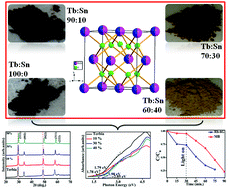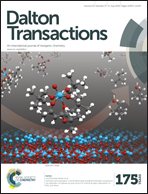Determination of solubility limit of Sn4+ in fluorite structured terbia with simultaneous evaluation of photocatalytic function†
Abstract
Although the fluorite structure is highly common among stoichiometric and non-stoichiometric terbia compositions, high pressures are necessary to stabilize SnO2 in the fluorite structure. With this objective, the extent of solubility of Sn4+ in terbia possessing the fluorite structure has been determined by conducting its synthesis via an epoxide mediated sol–gel method. Up to 40% of Sn4+ can be incorporated in terbia, which retains its fluorite structure, as concluded from PXRD, FTIR, Raman spectroscopy, FESEM, HR-TEM and SAED measurements. The cubic lattice constant decreases systematically, as inferred from successful Rietveld refinements of PXRD patterns. The stretching vibration of the Tb–O bond is manifested as broad band at 734 cm−1 for the terbia, and moves to lower wavenumber for the tin substituted samples. The broad band at 611 cm−1 in the Raman spectrum of terbia became even broader with the maxima shifting towards higher values, which indicated the strain of the lattice and generation of oxygen vacancies with progressive tin substitution. The band gap value increased from 1.78 eV for terbia to 2.05 eV for the 40% tin substituted sample. Emission in the blue region became intense upon tin substitution, which was indicative of increased oxygen vacancies and this has been constructively utilized for environmental remediation as a catalyst to degrade aqueous Rhodamine-6G and Methylene Blue dye solutions.


 Please wait while we load your content...
Please wait while we load your content...